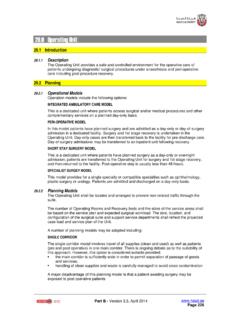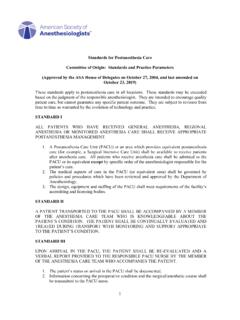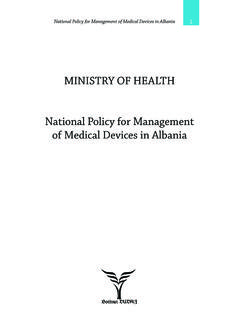Transcription of Guidelines for designing a digestive disease endoscopy ...
1 GuidelineGuidelines for designing a digestive disease endoscopyunit: Report of the World endoscopy OrganizationChris J. J. Mulder,1 Maarten A. J. M. Jacobs,1 Roger J. Leicester,2D. Nageshwar Reddy,4 Libby E. A. Shepherd,5 Anthony T. Axon3and Jerome D. Waye61 Department of Gastroenterology, VU University Medical Center, Amsterdam, The Netherlands,2 Surgery, endoscopy Department, St George s Hospital, London,3 Department of Gastroenterology, Leeds GeneralInfirmary, University of Leeds, Leeds, UK,4 Asian Institute of Gastroenterology, Hyderabad, India,5 LoganHospital, Brisbane, Australia, and6 Department of Gastroenterology, Mount Sinai Medical Center, New York.
2 USAA dedicated digestive disease endoscopy unit is structurally andfunctionally differentiating rapidly as a result of increasing diag-nostic and therapeutic possibilities in the last 10 20 years. Pub-lications with practical details are scarce, imposing a challenge inthe construction of such a unit . The lack of authoritative informa-tion about endoscopy unit design means that architects producetheir own design with or without consulting endoscopistsworking in such a unit . A working group of the World EndoscopyOrganization discussed and outlined a practical approach fordesign and construction of a modern endoscopy unit .
3 Designingthe layout is extremely important, necessitating thoughtful plan-ning to provide comfort to the endoscopy staff and patients, andefficient data archiving and transmission during words:construction, design, digestive disease , endoscopy ,mobilehospital,unitINTRODUCTIO NIN MANY HOSPITALS, endoscopy was first introducedby carrying out gastroscopies in an all-purpose room oroperating theater. The rapid development of endoscopy withall its diagnostic and therapeutic possibilities meant thatendoscopy units had to be remodeled or newly built as thedemand for endoscopic procedures increased.
4 This led to theneed for minimum requirements in the design and construc-tion of endoscopy lack of authoritative informa-tion about endoscopy unit design meant that architectsproduced their own design with or without consulting theendoscopists working in such ,3In practice, the majority of smaller units still do not fulfilthe criteria set by the British Society of Gastroenterologynearly 25 years minimum of two endoscopy rooms isessential for a small unit to enable parallel examinations ofupper and lower endoscopy and a three-room endoscopysuite for units carrying out 3000 endoscopies per ,2 Thethird room including X-ray is necessary for fluoroscopicendoscopic procedures such as endoscopic retrograde cho-langiopancreatography (ERCP), endoscopic ultrasonogra-phy (EUS)
5 And also permits flexibility indealing with emergencies and added cases without interrupt-ing the routine has continued to expand. These guidelineshave been developed by a working group from the WorldEndoscopy Organization as a design tool to assist medicalstaff, architects and management teams to better understandthe available choices. Before undertaking such a project, thedesign team should understand more about the functionalrequirements necessary for proper operation of the endos-copy AND OBJECTIVESTHE AIM OF an endoscopy facility is to provide high-quality diagnostic and therapeutic endoscopy comfortable environment for patients that maintains bothprivacy and dignity is mandatory in both private and publichospitals.
6 A safe environment for staff that caters to theirpersonal and professional needs is an essential requirementto ensure optimal efficiency and :Chris JJ Mulder, Department of Gastroenterologyand Hepatology, VU Medical Center, PO Box 7057, 1007 MBAmsterdam, The Netherlands. Email: 4 April 2013; accepted 11 April Endoscopy2013;25: 365 375doi: 2013 The AuthorsDigestive endoscopy 2013 Japan Gastroenterological endoscopy Society365 GENERAL CONSIDERATIONSENDOSCOPY UNITS MAY be sited in acute hospitals,stand-alone facilities or in large urban or rural , the basic requirements for design do not differwith regard to the internal facilities which remain the samewith the differences dependent on the scale of the unit andits location.
7 The digestive disease endoscopy unit is bestdivided into functional areas, such as: reception and waiting area preparation/recovery area endoscopy area support area: cleaning and storage staff and administration area education and training endoscopy units have been launched in SouthAfrica and India and are a promising concept that offers thecapability of diagnostic and therapeutic endoscopic proce-dures among patients from areas with limited accessibility tomodern health ,6 The mobile endoscopy bus initiated bythe Asian Institute of Gastroenterology in Hyderabad, Indiaincludes a bus customized as a mobile hospital that consistsof separate enclosures for the upper gastrointestinal (GI)
8 endoscopy and colonoscopy unit , transabdominal ultra-sonography facility and a basic laboratory busis accompanied by a team of physicians, endoscopists andtechnicians along with a mobile telemedicine unit (Fig. 1).All endoscopic procedures and data from field locations aretransmitted to the main telemedicine station of the parentinstitute. The entire endoscopy unit is equipped with abattery-powered inverter and a servo stabilizer to supplyenergy for the procedures. The bus is also modified with thecapability to draw power from external sources.
9 Oxygen andcompressed air is provided by an externally loaded oxygencylinder and a suction apparatus. The bus also has a constantwater supply from an inbuilt water tank with a sink with ahands-free powered tap. The endoscopies are conductedunsedated and manual cleaning of the endoscopes is done asper standard Guidelines . This Indian model should be con-sidered for other remote areas all over the units should be located in a space where theydo not open into a public waiting room or a high-trafficpublic corridor. Access to hallways by patients or staff whodo not work in the endoscopy unit should be endoscopies are carried out on a day-stay basis,allowing greater convenience for patients and less disruptionto other hospital services.
10 It also allows for a more efficientuse of resources by scheduling groups of similar a unit needs more than 200 500 X-ray screenings a year,then its own X-ray room is essential, which in a basic unitwould be the third the acute hospital setting, where possible, the endos-copy unit should be sited close to the emergency room,intensive care facility, acute wards and the operating room,in order to facilitate endoscopy in emergency cases. Analternative is a well-equipped trolley to service these units(Fig. 2). endoscopy UNITSize of endoscopy unitTHE SIZE OF the unit should be adequate to cope withboth current and future ,7In order to estimate therequired capacity, current workload must be assessed accu-rately after applying quality-control measures to ensure theappropriateness of the procedures and to take into accountchanges that may occur.







